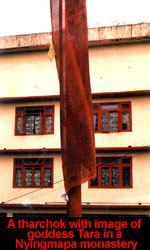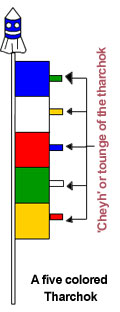Banner
/ Prayer flag is an integral part of Tibetan culture and folk ritual.
We can see this type of banner in the mainland of Tibet and the Himalayan
regions influenced by Tibetan culture, such as Leh, Ladakh, kulu, Manali,
Dharamshala, Nepal, Sikkim, Bhutan or Arunachal Pradesh.The Banners
are raised in Gompas (Buddhist monasteries), in house, or in burial grounds. In Tibetan language there
are called Tharchoks. Sutra and mantras are printed in Tibetan script
on the tharchoks.
monasteries), in house, or in burial grounds. In Tibetan language there
are called Tharchoks. Sutra and mantras are printed in Tibetan script
on the tharchoks.
However we find traces
of an other kind of banner which is not made of cloth and not printed
but inscribed insensible. In a journal of Asiatic society
we found an article about ‘Interpretation of the
Tibetan inscription on a Bhotian Banner taken in Assam, and presented
to the Asiatic society by captain Bogle. The interpreters name is signed
A.C. Koroshi and dated 1836.
He described the Banner as -" It may that the flag-staff,
with the wooden found containing this inscription was carried before
the Tibetan chief in his march, and so used as ensign in war; but it
is more probable that it belong originally to the house-ton or terrace
of the prince in Bhutan for the house of great patronage in that country
are generally decorated with such ensigns of victory at the four corners
of the terrace roof. They are called in Tibetan ‘rgyeltsen’ ( ensign
of victory) and always contain inscription of similar purpose with this".
There is no specific size for tharchok.
It depends upon the bamboo pole or post with which it is attached. But
in market some regular size of tharchoks are generally sold. Some monasteries
or organizations sometime raise larger size banners. These are ordered
specially. Now these are made by synthetic clothes. Even ten years back
all tharchoks were made by cotton cloth.
Tharchok can be white or colored. The color is entirely
dependant upon the purpose for which a tharchok is raised. The tharchoks
which are raised at the time of funeral must be colored white. These
are called ‘MANI’. The cause of this name is that these tharchoks are
printed with the six syllable mantra Tibetan tantric Buddhism ‘OM MANI
PEME HUM’ entirely.
The others are colored tharchoks. These are sometimes five
colored or some times single colored. The colors are entirely dependant
upon the Tibetan cosmology and astrology. The five colors in a tharchoks
are arranged as blue, white, red, green and yellow respectively from
top to bottom. These five colors are symbols of five elements according
to Tibetan cosmology. These five elements (‘Kham’ in Tibetan) are water,
iron, fire, plant and earth. This is described in the table below.
| |
FIVE
ELEMENTS
(KHAM) |
TIBETAN
NAME |
SYMBOLIC
COLOR |
| 1 |
WATER |
CHU |
BLUE |
| 2 |
IRON |
CHYIA |
WHITE |
| 3 |
FIRE |
MEH |
RED |
| 4 |
PLANTS |
SHING |
GREEN |
| 5 |
EARTH |
SHAH |
YELLOW |
Besides these are single colored tharchoks - Colors of these tharchoks
depend upon the colors astrologically favorable to the person who is
raising the tharchok. The Tibetan astrology follows Chinese lunar calendar.
This lunar almanac is made upon a circle of twelve successive years,
where each year is symbolized by twelve animals - rat, ox, tiger, rabbit,
dragon, snake, horse, sheep, monkey, rooster, dog and boar. Furthermore
each of the five elements of ‘Khams’ is attached to two successive years. In this way
five elements multiplied to twelve animals form a circle of 60 (5×12)
year. This is called one ‘Rapchung’, where each animal became connected
with each element.
elements of ‘Khams’ is attached to two successive years. In this way
five elements multiplied to twelve animals form a circle of 60 (5×12)
year. This is called one ‘Rapchung’, where each animal became connected
with each element.
The first Rapchung was 1027 A.D. So at the time of raising the their choke
the element and animal specifying the date of birth of the raiser is
counted. Astrologer (`Tsipa' in Tibetan) is called for this purpose.
This person calculate the almanac and according to that the color of
the tharchok is decided. The appropriate time for raising the tharchok
is also mentioned by the almanac.
 Another
interesting factor is that the side, which is opposite to the side attached
to the pole, or the side which sway in the air, has small rectangular
pieces of cloth stitched at the end. These are also found in five colors.
In case of mani or white tharchok there are orange Another
interesting factor is that the side, which is opposite to the side attached
to the pole, or the side which sway in the air, has small rectangular
pieces of cloth stitched at the end. These are also found in five colors.
In case of mani or white tharchok there are orange colored. Tibetan language it is called ‘Chyeh’, Which means tongue.
Tharchok is a printed prayer and the mantra and printed on it fly across
the air. With these symbolic tongue tharchok or prayer flags utter the
prayer - Is this type of imagination source of creation of ‘Chyeh’ or
tongue?
colored. Tibetan language it is called ‘Chyeh’, Which means tongue.
Tharchok is a printed prayer and the mantra and printed on it fly across
the air. With these symbolic tongue tharchok or prayer flags utter the
prayer - Is this type of imagination source of creation of ‘Chyeh’ or
tongue?
TYPES OF THARCHOK - The tharchok varies according to
the printed diagram upon it. Different tharchok are raised for deferent
purposes. Generally the invitation of good luck, the prosperity in mortal
and transcendental life are the main inspirations. At this point this
custom is not different from any other folk custom or ritual. The tharchoks
varies according to this types : -
1) MANI :- These are specially used for funeral rites. Generally
‘Mani’s are seen in burial grounds. These are white colored with orange
tongues and without any image or diagram. Only the six syllable mantra
‘OM MANI PEME HUM’ is printed on it. By this mantra it is related with
"CHENREJIG" (Avolokiteswara)
2) LUNGDAR (WIND HORSE) :- Lungdar is raised for the profit
in business. ‘Lung’ means wind and ‘dar’ means wind. At the center of
it an image of a horse a is printed.
3) GYELTSEN CHEMO (BANNER OF VICTORY) :- This symbolize the
glory of victory. in ancient time it was used after victory in war.
An image of cylindrical banner is printed the center and mantra is printed
around. It is also included in ‘TASHI TAGGYE’ or Eight auspicious signs
are used in ritual, religious procession, proclaiming the victory of
piety over evil.
4) VAJRAGURU THARCHOK : - These are also white in color.
In this banner, the image of Vajraguru PadmaSambhava (Tibetan name Guru
Rimpoche) is printed. His mantra "OM AH HUM VAJRAGURU PEME SIDDMI
HUM" is printed in this tharchok. Beside these are general tharchoks
on which mantra, sutra, image of Buddha, Goddess Tara, stupa, lion,
Dragon etc. are printed.


At the time of raising the tharchok ‘sang’ also offered. Offering sang
or juniper smoke came from pre-Buddhist Bon tradition. ‘Sangkang’ a
white pot bellied chimney containing the hearth is to be fund in almost
every gompa.
Though we see tharchok as a process of visual ‘JAPA’ other than Mahayana
Buddhist Tradition, Tibetan astrology and cosmology also contributed
largely in formation of this particular ritual.
‘Losar’ or Tibetan new year is the largest festival in Tibetan life
and for this special occasion tharchok is made. This comes generally
in the month of January on march. At the last day of the year monks
perform, ‘Tor-sor’ ceremony to exorcise the evil spirit. 9,19 or 29
offerings are made to wrathful deities. ‘Linga’ an image which represents
the evil spirit is thrown away with offering, gunshot and a sacred dance.
They print image of ‘Linga’ and ‘Mahabal’ for this ceremony. Printer’s
of Rumtek monastery make much images.
Tharchoks are hung at this time from one rock to another
rock along the hillsides, and between every two tharchok, horoscope
of every member of the family is tied. The reason behind it is same
as tharchok raising. Here it is the joint prayer from the whole family.
In this way religion, spirituality,
ritual everything supported the growth of printing practice within this
culture. Practically printing as a craft or art form has no separate
existence here, but always related with some kind of belief closely
related with life.
|